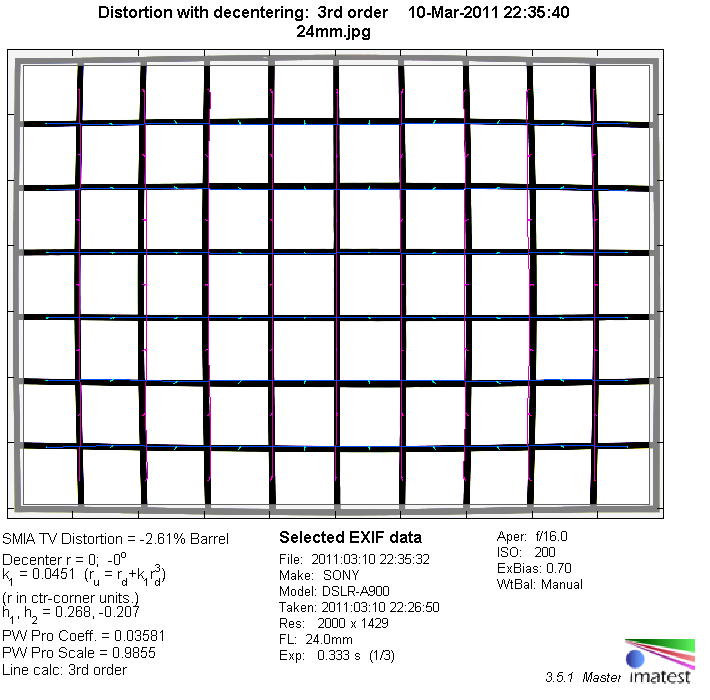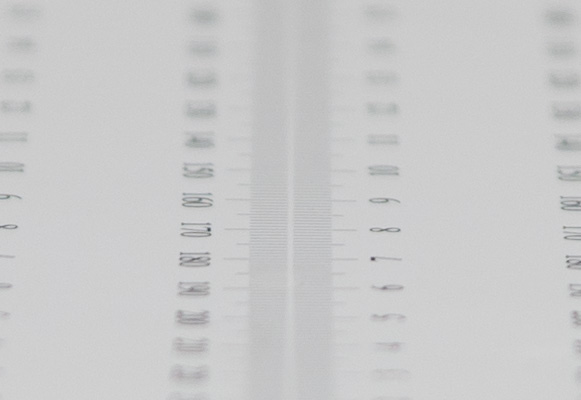|
Zeiss Vario-Sonnar T* 24-70mm f/2.8 ZA SSM (Sony SAL-2470Z) - Review / Lab Test Report - Analysis |
|
Lens Reviews -
Sony Alpha (Full Format)
|
|
Page 2 of 2

Distortion
The Zeiss lens shows a quite strong amount of barrel distortion (2.6%) within its native image format. This is roughly what you can expect from such a lens though. There is basically no distortion at 40mm and just a slight degree of pincushion distortion at 70mm.
|
Move the mouse cursor over the focal length text marks below to observe the respective distortions
|
| 24mm |
40mm |
70mm |

|
Vignetting
Typical for most full format lenses it produces a rather hefty light-falloff at max aperture specifically towards the wide end. This will be easily visible in field images. Stopping down to f/4 resolves the issue at 40mm/70mm but you'll have to live with some vignetting at 24mm even at f/8 (@ 0.9EV). Overall this is somewhat worse than average.

MTF (resolution)
The resolution figures are a bit mixed on a full format DSLR. The center resolution is nothing short of breathtaking throughout the range. However, the border/corner resolution isn't quite as good. The border performance is just fine at 24mm even at f/2.8 but the corners are soft here and they improve only gradually. There's also some field curvature here which doesn't exactly improve the situation. You need to stop down to f/8, better f/11, in order to achieve a very good quality across the image frame. The 40mm setting is the sweet spot - maybe less so at max. aperture where we can still see some corner softness but from f/4 the results are highly impressive. At 70mm there's a bit of a performance penalty regarding the borders but they remain on a very good level.
The corners are a bit softer but they catch up at f/4 already.
Please note that the MTF results are not directly comparable across the different systems!
Below is a simplified summary of the formal findings. The chart shows line widths per picture height (LW/PH) which can be taken as a measure for sharpness.
If you want to know more about the MTF50 figures you may check out the corresponding Imatest Explanations
Chromatic Aberrations (CAs)
Lateral chromatic aberrations (color shadows at harsh contrast transitions) are generally quite well controlled. You may still be able to notice some CAs in field images when using a wide-angle setting (~1.5px). The problem eases when zooming towards the long end of the range.
 Needless to say but you can correct or at least reduce lateral CAs during post-processing e.g. via Photoshop.
Needless to say but you can correct or at least reduce lateral CAs during post-processing e.g. via Photoshop.
Bokeh (out of focus blur)
The quality of the bokeh is not a strength of the Zeiss lens - at least not at 70mm but this is surely the most interesting spot to look for.
The out-of-focus hightlights show a rather pronounced outlining effect and hard contrast edges can produce halos rather than a soft fading. This is somewhat disappointing.
 The foreground blur (to the left below) is Okay albeit not great but the background blur (to the right below) is very nervous.
The foreground blur (to the left below) is Okay albeit not great but the background blur (to the right below) is very nervous.
 Here's a 100% sample crops illustrating the problem in a field image (taken from our APS-C review):
Here's a 100% sample crops illustrating the problem in a field image (taken from our APS-C review):

Bokeh Fringing / LoCAs
Lateral CAs occur in the image plane whereas LoCAs, sometimes referred to as "bokeh fringing", are present on the focus axis. They show up as green contrast halos in front and purple halos beyond the focus point. Large aperture lenses tend to have problems here but the Zeiss does actually a good job here. There're only slight traces of the issue even at f/2.8.

Verdict
The Zeiss Vario-Sonnar T* 24-70mm f/2.8 ZA SSM produced outstanding performance figures in our APS-C test but it's not quite as good when used within its native full format scope. It is, of course, still able of delivering an outstanding center resolution but the corner quality disappoints at 24mm when using large to medium aperture settings. You may argue that the quality is fine at mainstream settings here (f/8-f/11) but for this amount of money you simply expect better results here. The lens is certainly very sharp at 40mm and still pretty good at 70mm. Lateral CAs may be visible at times in wide-angle images but it's a non-issue in the middle to upper zoom range. A rather disappointing aspect of the lens is the quality of the bokeh (character of the out-of-focus blur) which could be better @ 70mm f/2.8 - this may cause headaches for some users. Bokeh fringing is very well controlled though. The lens is somewhat prone to flare.
The build quality of the Zeiss is very good although we expected a tad less plastic and some sort of sealing in a lens targeting the professional market. A highlight of the lens is the extremely fast and silent SSM AF drive - if you think the Canon or Nikkor variants are fast here you may need to prepare yourself for a surprise. The Sonnar is an expensive lens but despite its shortcomings you'll probably have a hard time to find anything better for a full format Sony Alpha DSLR (the Sony 28-75mm f/2.8 seems worse based on our preliminary tests).
|